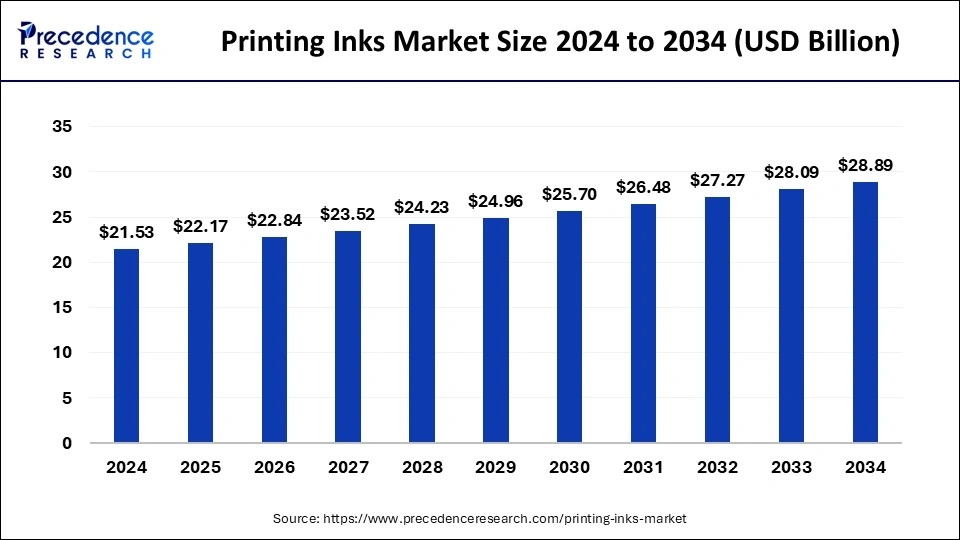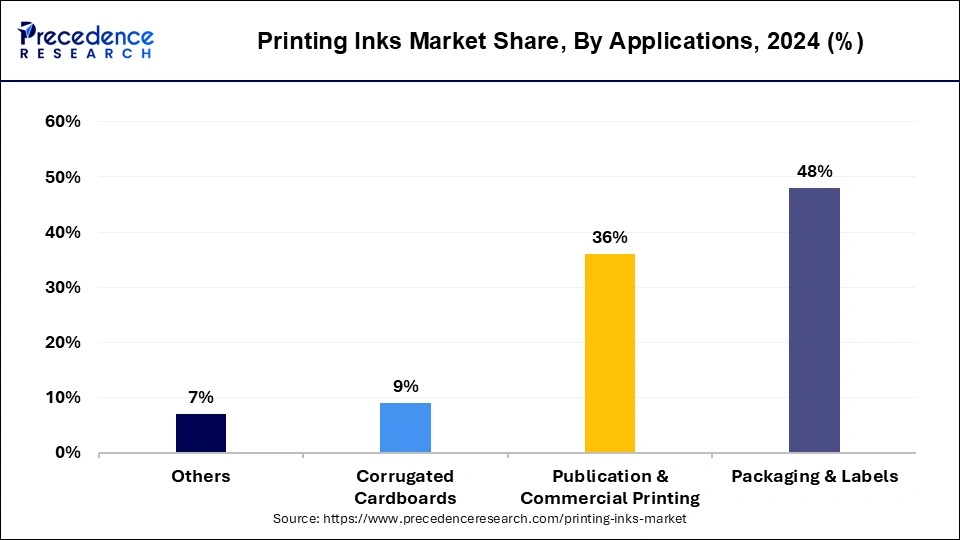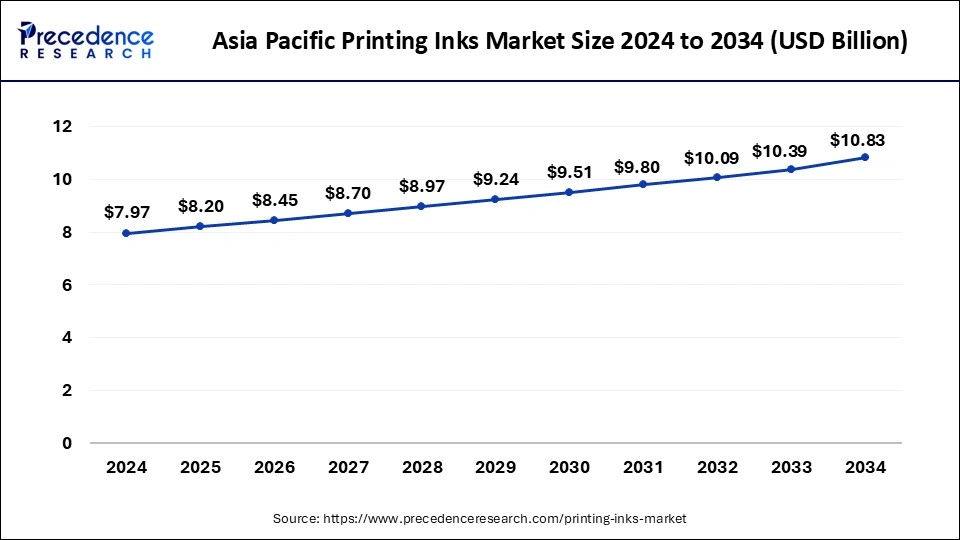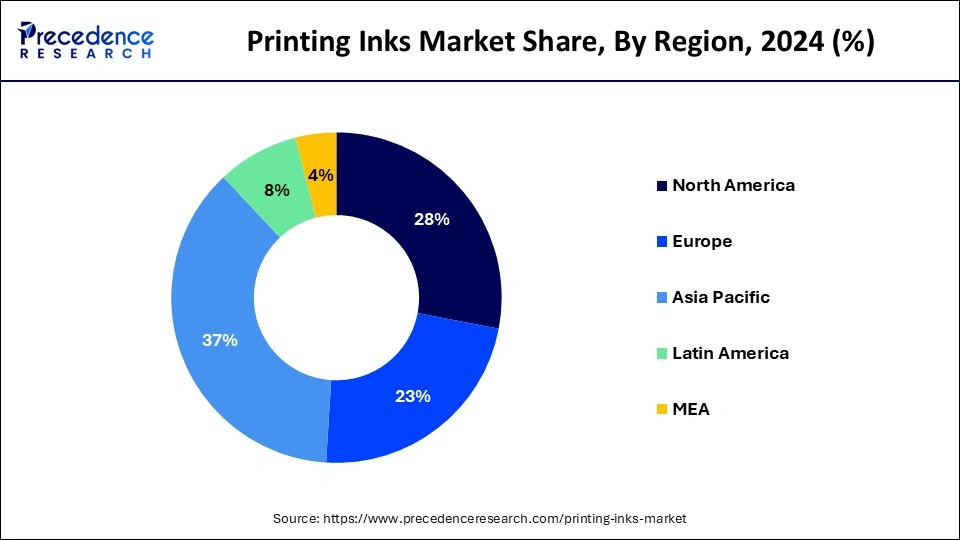What is the Printing Inks Market Size?
The global printing inks market size is accounted at USD 22.17 billion in 2025 and predicted to increase from USD 22.84 billion in 2026 to approximately USD 28.89 billion by 2034, expanding at a CAGR of 2.98% from 2025 to 2034. The rising demand for printing ink from several printing applications is driving the growth of the market.

Printing Inks Market Key Takeaways
- Asia Pacific led the market with the largest revenue share of 37% in 2024.
- North America is expected to witness the fastest growth during the forecast period.
- By product, the lithographic segment dominated the market with the highest market share in 2024.
- By resin, the polyurethane segment is projected to grow with the fastest CAGR during the forecast period.
- By application, the packaging & labels segment has held a major revenue share of 48% in 2024.
What are the Diverse Applications of the Printing Inks?
Printing inks are specialized solutions or pastes that include binders, pigments, solvents, and additives. Printing ink is used in various applications like images, the printing process to transfer texts, and printing designs on cardboard, paper, packaging, fabric, and packaging materials. Printing ink depends upon three major factors: gloss, color, and transparency. Pigment ink, solid ink, dye-based ink, sublimation ink, and ribbon ink are some types of printing ink. The increasing demand for printing ink from various applications like packaging, digital printing, newspaper, commercial printing, specialty printing, and others is driving the growth of the printing inks market.
Printing Inks Market Growth Factors
- The rising demand for printing ink from several end-use applications like printing, commercial printing, packaging, packaging labels, labelling, and publishing drives the growth of the market.
- The rising demand for consumer goods by economically developed countries and the surge in population income are contributing to the market's growth.
- The rising industrialization and manufacturing industry are positively impacting packaging and labeling, directly influencing the demand for printing ink to instruct information about the product on the surface.
- The rise in the digital printing industry and commercial printing, as well as the rise in bio-based printing ink, collectively drives the demand for the printing inks market.
- The rising demand for the consumer goods, food, and beverages industry is driving the demand for the packaging industry, which positively influences the growth of the printing inks market.
Printing Inks Market Outlook
- Global Expansion: A rise in the packaging industry, the booming digital printing, and an extensive focus on sustainable, eco-friendly inks are impacting the overall progression.
- Major Investor: In 2025, Sun Chemical invested $100 million in a new U.S. facility to expand supply chain resilience and meet packaging ink demand.
- Startup Ecosystem: In 2024, DIC Corporation rolled out a bio-resin ink for compostable packaging and acquired a stake in a European digital inkjet startup.
Market Scope
| Report Coverage | Details |
| Market Size in 2025 | USD 22.17 Billion |
| Market Size in 2026 | USD 22.84 Billion |
| Market Size by 2034 | USD 28.89 Billion |
| Growth Rate from 2025 to 2034 | CAGR of 2.98% |
| Largest Market | Asia Pacific |
| Base Year | 2024 |
| Forecast Period | 2025 to 2034 |
| Segments Covered | Product, Resins, Applications, and Regions |
| Regions Covered | North America, Europe, Asia-Pacific, Latin America, and the Middle East & Africa |
Market Dynamics
Driver
Rising demand from the packaging industry
The expansion of the consumer goods and food and beverage industry is driving the demand for the packaging industry for packaging products. The packaging industry heavily depends on printing ink; printing ink plays an important role in providing information about the content, brands, usage instructions, manufacturing and expiry dates, and others. It is used to enhance the visual appearance of the product. Printing ink is used in a wide range of applications in the packaging industry, such as labelling, corrugated boxes, flexible packaging, and cartoons.
Additionally, printing ink is also important in newspaper and periodical printing. Newspapers provide clear and legible text and colorful images and are used to enhance the overall quality. Newspaper printing ink can maintain a high-speed printing process without smearing or smudging. Thus, the rising adoption of printing inks from several end-use applications like labeling printing, newspaper printing, and others is driving the growth of the printing inks market.
Restraint
High prices
The increase in the price of printing ink due to the higher competition in the industry and the strict government regulations like the U.S. Food and Drug Administration and the Federal Food, Drug, and Cosmetic Act are restraining the growth of the printing inks market. Other factors that make the inks expensive are the research and development that is done to make high-quality inks that have features like water resistance, quick drying, and color accuracy. Also, organizations majorly use the razor and blade business model for selling inks in which they sell printers at a low cost, which ultimately leads to the high cost of inks for compensation for the loss.
Opportunity
Rising demand for eco-friendly printing inks
The rising concern about environmental pollution is driving the demand for eco-friendly printing inks. There is rising research on the development of eco-friendly printing ink, like vegetable-based inks, made from renewable resources like linseed and soybean oil. Vegetable-based printing ink is biodegradable and reduces VOC emissions, which makes it the ideal choice in terms of lowering environmental pollution. However, there are more environmentally friendly printing inks that are gaining popularity, like water-based inks and UV-curable inks, which have less VOC emission and are easier to clean compared to traditional inks. Ongoing research and development of more eco-friendly printing ink options are driving the growth opportunity in the printing inks market.
Product Insights
The lithographic segment dominated the printing inks market with the highest market share in 2024. The growth of the segment is attributed to its use in large-scale printing production. Lithographic printing is offered in materials like foil, cloth, plastic, paper, and cardboard. It is generally done on flat surfaces. There are several benefits of using lithographic printing, such as high-quality prints that are produced using several coatings and finishes. The machines used in this type of printing are capable of using six colors, including metallic inks. It provides a large quantity of packages that can be printed in a short time. It is also economically better in the long run.
The gravure printing segment also has a significant share of the printing inks market. Gravure printing is being used more and more in various product applications, such as food packaging, cosmetics, and tobacco products. This type of printing can be done on materials like paper, cardboard, foils, labels, and plastics. This printing style is used for printing large volumes of catalogs, magazines, and other products that need to be printed in large numbers. This printing is capable of providing continuous tone images with consistent print quality. The procedure is automated, which requires less human interaction and causes fewer human errors.
Resin Insights
The polyurethane segment is projected to grow at the fastest rate during the forecast period. The increasing use of polyethylene in the production of several types of printing inks drives the demand for the segment in the market. The ink made from polyethylene is used in various end-use industries like textile, automotive, and packaging. Polyethylene ink has exceptional durability and flexibility over cracking, peeling, and blending and resists all environmental conditions. It has properties like adhesion, high resistance to chemicals and abrasion, rapid curing time, and longer color vibrancy. It offers excellent flexibility in terms of printing on materials like cloth, paper, plastics, cardboard, and others. It is also an ideal choice for environmental impacts; it emits low VOC compared to traditional ink. Thus, the higher adoption of polyurethane due to its eco-friendly and cost-affordable properties is driving the growth of the segment in the printing inks market.
Application Insights
The packaging & labels segment dominated the printing inks market with the largest market share in 2024. The growth of the segment is attributed to the rising global population that tends to the higher demand for package products due to the shifting lifestyle preferences and disposable income that drives the consumer goods industry, which impacts the growth of the demand for packaging and labels.

Printing ink plays an important role in the packaging and labeling of the product; it clearly shows the information and brand awareness of the product. Thus, the rising demand for convenience packaged products is due to demand from packaging and labeling applications, driving the growth of the printing inks market.
Regional Insights
Asia Pacific Printing Inks Market Size and Growth 2025 to 2034
The Asia Pacific printing inks market size is estimated at USD 8.20 billion in 2025 and is predicted to be worth around USD 10.83 billion by 2034 with a CAGR of 3.11% from 2025 to 2034.

Asia Pacific led the printing inks market with the largest market share in 2024. The growth of the market in the region is attributed to the rising industrial development. The rising regional population is driving the demand for industries like consumer food and FMCG, which drives the demand for the high-end packaging industry that highly relies on printing ink for printing and labeling on the surface of the product, which contributed to the growth of the market in the region. The rising investment by the public and private sectors in industrial and manufacturing development drives the growth of the printing inks market in the region.
India is significantly contributing to the growth of the printing inks market. India is printing books, journals, and other products and exporting them to more than 129 countries. India is also investing in new technology to improve printing quality and quantity. India has some of the major organizations for printing, including IPAMA, and AIFMP. AIFMP, which is the world's largest printing association, is contributing to the growth. Key players are also investing in India for growth and development.
- For instance, in May 2024, Canon India launched six new large-format printers. With the, 7 new color categories was launched as part of the ImagePrograf GP series (GP 526S/546S/566S) customized for the graphics art market with supporting the latest Lucia Pro II pigment ink for delivering attractive print quality for eye-catching photographs and posters.

North America is expected to witness the fastest growth during the forecast period. The growth of the market is owing to the well-developed industrial infrastructure and the rising demand for the packaging industry is contributing in the expansion of the market in the region. The availability of the major manufacturing hub in the countries like the U.S. and Canada is driving the growth of the printing inks market across the region.
- In May 2024, DuPont launched the two latest Artistri inks for Drupa: the P1600 series for direct-to-film and the N1000 Series for commercial printing. These water-based inks are intended for the packaging industry.
Growth in Digital Printing & Energy-Curing Inks: U.S. Market Trend
The US is experiencing a transforming expansion in digital printing due to the increasing demand for on-demand printing, mass tailoring, short print runs, and quicker turnaround times. Ink manufacturers are escalating the development of high-speed, high-quality digital inks for various substrates like flexible packaging and textiles. Also, the major companies are launching UV-curable and LED-curable inks with expanded durability and low-migration features.
Inclusion of Advances & Regulatory Compliance is Fueling Europe
Europe has had notable expansion in the printing inks market, due to the widespread contribution of their regulations, like the EU Packaging and Packaging Waste Regulation (PPWR), REACH, and the German Printing Ink Ordinance. Alongside, the market spurring smart and functional inks for RFID tags, NFC, printed sensors, OLED displays, and photovoltaics is an important growth area.
Increasing Emphasis on Packaging: German Market
Ongoing progression of the German Market is impelled by the persistent focus on the packaging industry, mainly for food, beverage, and e-commerce, which is a robust catalyst of ink demand. Furthermore, German manufacturers are heavily investing in evolving low-migration inks for food contact materials to ensure safety and compliance.
Major Steps in Sustainability are Supporting Latin America
Latin America is a significant testing ground for novel and sustainable approaches. This is further encouraging enhancement in water-based inks and bio-based alternatives, specifically algae-based inks, which are widely utilised by major brands globally.
Brazil's Ink Boom
The Brazilian printing inks market is growing due to strong demand from the food and beverage packaging sectors. As the country's economy recovers and e-commerce expands, the need for high-quality, sustainable inks for product branding and labeling drives steady market expansion.
Printing Inks Market: Value Chain Analysis
- Feedstock Procurement
This mainly includes sourcing four primary raw material components, such as pigments, binders (resins), solvents, and additives.
Key Players: DIC Corporation, Hubergroup, Hubergroup, ALTANA, etc. - Quality Testing and Certification
The market explores a complete evaluation of properties, such as colour, adhesion, and durability, along with raw material analysis and adherence to standards, including ISO and UL.
Key Players: Intertek, QIMA, Alfa Chemistry, etc. - Regulatory Compliance and Safety Monitoring
This leverages adherence to global standards that limit hazardous substances and mitigate migration into products.
Key Players: NanoMatriX Technologies, VerifyMe, Authentix, etc
Key Players Offerings:
- Flint Group- A leading player provides diverse conventional, water-based, UV-curable, and digital inks for different applications.
- DIC Corporation- A prominent company that offers offset, gravure, and flexographic inks for packaging, commercial, and industrial applications.
- Siegwerk Druckfarben AG & Co. KGaA- It promotes a bunch of printing inks and coatings, mainly used in packaging applications, labels, magazines, and catalogues.
- Sakata Inx Corporation- A player that offers specialized and eco-friendly options, like waterless inks, toluene/ketone-free products, and soy oil-based inks.
- T&K TOKA Corporation- It is a specialist in UV-curable inks, with an emphasis on the development of energy-saving and sustainable products like low-energy curing UV and EB inks.
Printing Inks Market Companies
- Flint Group
- DIC Corporation
- Siegwerk Druckfarben AG & Co. KGaA
- Sakata Inx Corporation
- T&K TOKA Corporation
- Dainichiseika Color & Chemicals Mfg. Co., Ltd.
- DEERS I CO., Ltd.
- Epple Druckfarben AG
- TOYO INK SC HOLDINGS CO., LTD.
- Hubergroup
- TOKYO PRINTING INK MFG CO., LTD.
Recent Developments
- In May 2024, Landa Digital Printing launched the next-generation B1 digital print technology, S11P Nanographic Printing Presses, and Landa S11. The launch will demonstrate enhanced production versatility and a print speed of 11,200 sph.
- In May 2024, Electronics For Imaging Inc. launched a wide range of solutions on inkjet printing packaging, textiles, and display graphics for the display on its stand at Drupa 2024.
- In May 2024, BIO INX and Readily3D launched the READYGEL INX for the revolutionary 3D approach of printing “Volumetric 3D Printing,” which is necessary for reverse CT scanning.
- In May 2024, Packsize, a leading market player in right-sized, sustainable, and on-demand packaging company, is collaborating with the EFI™, a leading technology company in revolutionizing from analog to digital imaging for the launch of an on-demand box system that combines full-color printing on boxes with the use of single automated solutions.
- In May 2024, Mimaki Engineering Co. Ltd. launched its carton ink cartridge; it is the move towards the replacement of traditional plastic cartridges with environmentally friendly paper alternatives and the significant trend toward the sustainable printing industry.
Segments Covered in the Report
By Product
- Gravure
- Flexographic
- Lithographic
- Digital
- Others
By Resins
- Modified Rosin
- Modified Cellulose
- Acrylic
- Polyurethane
- Others
By Applications
- Packaging & Labels
- Corrugated Cardboards
- Publication & Commercial Printing
- Others
By Geography
- North America
- Asia Pacific
- Europe
- Latin America
- Middle East & Africa
For inquiries regarding discounts, bulk purchases, or customization requests, please contact us at sales@precedenceresearch.com
Frequently Asked Questions
Ask For Sample
No cookie-cutter, only authentic analysis – take the 1st step to become a Precedence Research client
 sales@precedenceresearch.com
sales@precedenceresearch.com
 +1 804-441-9344
+1 804-441-9344